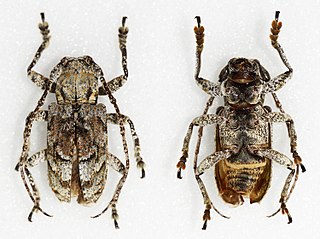Francis Polkinghorne Pascoe was an English entomologist mainly interested in beetles.

Cerambycinae is a subfamily of the longhorn beetle family (Cerambycidae). The subfamily has a world-wide distribution including: Asia, Europe and the Americas. Within the family, the only subfamily of comparable diversity is the Lamiinae.

Lepturges is a genus of longhorn beetles of the subfamily Lamiinae. It was described by Henry Walter Bates in 1863.
Cotyclytus is a genus of beetles in the family Cerambycidae, containing the following species:
Lepturgantes is a genus of beetles in the family Cerambycidae. The genus is placed in subfamily Lamiinae and tribe Acanthocinini.

Glenea is a genus of longhorn beetles belonging to the family Cerambycidae, subfamily Lamiinae.

Ropica is a genus of beetles in the family Cerambycidae, containing the following species:
Anaches is a genus of longhorn beetles of the subfamily Lamiinae. The genus is distributed in South, Southeast, and East Asia, from India and Nepal eastward to China and Taiwan.

Rhytiphora is a genus of flat-faced longhorn beetles in the Pteropliini tribe of the subfamily Lamiinae. The genus was first described in 1835 by Jean Guillaume Audinet-Serville.
Cylindrepomus peregrinus is a species of beetle in the family Cerambycidae. It was described by Francis Polkinghorne Pascoe in 1858.
Brimus spinipennis is a species of beetle in the family Cerambycidae. It was described by Francis Polkinghorne Pascoe in 1858. It is known from the South African Republic.

Prosopocera myops is a species of beetle in the family Cerambycidae. It was described by Louis Alexandre Auguste Chevrolat in 1855. It is known from Nigeria, the Ivory Coast, the Republic of the Congo, the Democratic Republic of the Congo, and Sierra Leone.
Anaches medioalbus is a species of beetle in the family Cerambycidae. It was described by Stephan von Breuning in 1956. It is known from Taiwan and China, including Hong Kong.
Anaches wenhsini is a species of beetle in the family Cerambycidae. It was described in 2013. It is endemic to Taiwan.
Anaches yitingi is a species of beetle in the family Cerambycidae. It was described in 2013. It is endemic to Taiwan.

Rhytiphora maculicornis is a species of beetle in the family Cerambycidae. It was described by Francis Polkinghorne Pascoe in 1858. It is from Australia.
Rhytiphora lateralis is a species of beetle in the family Cerambycidae. It was described in 1858 by Francis Polkinghorne Pascoe as Symphyletes lateralis. It is known from Australia.
Anaches cylindricus is a species of beetle in the family Cerambycidae. It was described by Judson Linsley Gressitt in 1939. It is endemic to southeastern China.
Oberea rubetra is a species of beetle in the family Cerambycidae. It was described by Francis Polkinghorne Pascoe in 1858. It is known from Sumatra, Borneo and Malaysia.
Serixia prolata is a species of beetle in the family Cerambycidae. It was described by Francis Polkinghorne Pascoe in 1858.






